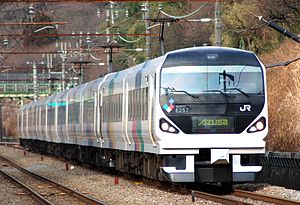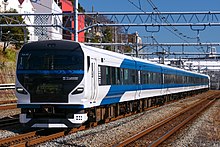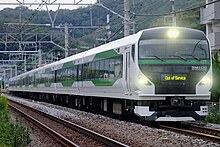E257 series
This article has multiple issues. Please help improve it or discuss these issues on the talk page. (Learn how and when to remove these template messages)
|
| E257 series | |
|---|---|
 An E257-0 series train on a Chuo Line Azusa service in January 2008 | |
| In service | 2001–Present |
| Manufacturer | Hitachi, Kinki Sharyo, and Tokyu Car Corporation |
| Family name | A-train[citation needed] |
| Replaced | 183/189 series, 185-0 series |
| Entered service | 1 December 2001 |
| Number built | 249 vehicles |
| Number in service | 249 vehicles |
| Successor | E353 series |
| Formation | 2/5/9 cars per trainset |
| Operator(s) | JR East |
| Depot(s) | Matsumoto, Makuhari, Omiya |
| Line(s) served | E257-0 (2001-2019): E257-500 (2004–): E257-2000/-2500 (2020–): |
| Specifications | |
| Car length | 21 m (68 ft 11 in) (end cars) 20.5 m (67 ft 3 in) (intermediate cars) |
| Doors | 2 per side |
| Maximum speed | 130 km/h (81 mph) |
| Traction system | IGBT-VVVF (Mitsubishi Electric) |
| Traction motors | 3-phase AC squirrel-cage induction motors (Mitsubishi Electric) |
| Acceleration | 0.56 m/s2 (1.3 mph/s) |
| Deceleration | 1.4 m/s2 (3.1 mph/s) |
| Electric system(s) | 1,500 V DC overhead lines |
| Current collector(s) | Pantograph |
| Braking system(s) | Regenerative brake, electronically controlled pneumatic brakes, snow-resistant brake |
| Safety system(s) | ATS-SN, ATS-P |
| Track gauge | 1,067 mm (3 ft 6 in) |
| Notes/references | |
This train won the 45th Blue Ribbon Award in 2002. | |
The E257 series (E257系, E257-kei) is a DC electric multiple unit (EMU) train type operated in Japan for limited express services by East Japan Railway Company (JR East) and built jointly by Hitachi, Kinki Sharyo, and Tokyu Car Corporation.
Variants
- E257-0 series: Azusa, Kaiji
- E257-500 series: Sazanami, Wakashio, Shiosai, Ayame
- E257-2000/-2500 series: Odoriko, Shōnan
- E257-5000/-5500 series: additional services
Four variants exist: the original E257-0 series for use on Chūō Main Line Azusa and Kaiji limited-express services until 16 March 2019 (displaced by E353 series EMUs), the E257-500 series for use on Chiba area limited express services (Uchibo Line Sazanami, Sotobo Line Wakashio, Sōbu Main Line Shiosai, and Narita and Kashima Lines Ayame),[1] the E257-2000/-2500 used for Odoriko services modified from former E257-0 and -500 series trains, and the E257-5000/5500 from former E257-0 and -500 trains for use on additional and charter services.[citation needed]
E257-0 series
This sub-series was introduced on 1 December 2001 to replace the aging 183 and 189 series rolling stock on Chuo Main Line Azusa and Kaiji services. Based at Matsumoto depot, the fleet consisted of sixteen 9-car sets (M101 to M116) with a full cab at the Matsumoto end and a gangwayed cab at the Tokyo end, and five 2-car "add-on" sets (M201 to M205) with a full cab at the Tokyo end and a shunting cab at the Matsumoto end.
The type was the recipient of the 45th Blue Ribbon Award (2002) of the Japan Railfan Club.
From 2018, the E257 series trains were replaced by E353 series EMUs on Chuo Main Line Azusa and Kaiji limited express services.[2] From the start of the revised timetable on 16 March 2019, E257 series trains were no longer used on regular Chuo Main Line limited express services. The trains were modified into E257-2000 series trainsets and redeployed on Tokaido Main Line Odoriko services from 14 March 2020. Several sets are still under refurbishment and three sets which has been reserved to be used on charter and extra services were modified into E257-5000s.
Operations
Former operations
- Chūō Main Line, Shinonoi Line, and Oito Line
- Azusa: Chiba - Tokyo - Shinjuku - Matsumoto - Minamiotari
- Kaiji: Tokyo - Shinjuku - Kōfu - Ryūō
- Chūō Liner: Tokyo - Shinjuku - Hachiōji - Takao (now replaced by Ldt. Express Hachioji)
- Ōme Liner: : Tokyo - Shinjuku - Tachikawa - Ōme (now replaced by Ldt. Express Ōme)
- Rapid service (no additional charge required): Matsumoto - Nagano
Matsumoto-based E257 series trains were also used on the Ohayo Liner Shinjuku and Home Liner Odawara commuter services running on the Tokaido Main Line until 14 March 2008.
Formations
The nine-car sets (M101 to M116) were formed as follows.[3]
| Car No. | 3 | 4 | 5 | 6 | 7 | 8 | 9 | 10 | 11 |
|---|---|---|---|---|---|---|---|---|---|
| Designation | Tc | M | M' | M | T | Ts | M | M' | Tc' |
| Numbering | KuHa E257-100 | MoHa E257 | MoHa E256 | MoHa E257-1000 | SaHa E257 | SaRoHa E257 | MoHa E257-100 | MoHa E256-100 | KuHa E256 |
- Cars 4, 6, and 9 were each fitted with one PS37 single-arm pantograph.
The two-car sets (M201 to M205) were formed as follows.[3]
| Car No. | 1 | 2 |
|---|---|---|
| Designation | Tc | Mc |
| Numbering | KuHa E257 | KuMoHa E257 |
- Car 2 is fitted with one PS37 single-arm pantograph.
Interior
E257-500 series
The E257-500 sub-series version was delivered between July 2004 and October 2005, with the first sets entering service from 16 October 2004 on Uchibo Line Sazanami and Sotobo Line Wakashio limited-express services, replacing older 183 series rolling stock.[4] Based at Makuhari depot in Chiba Prefecture, the fleet consists of 19 5-car sets (NB01 to NB19).[3] Unlike the Chūō Line variant, these sets have gangways at both ends.
Due to the reduction of the Chiba area limited express services, several trains are being used for the Chuo and Fujikyuko Line Fuji Excursion services and other charter and extra services. In addition to these, 4 sets are planned for conversion into E257-2500 to be used on Tōkaidō Main Line Odoriko limited express services, with further 5 sets to be converted to E257-5500 for use on additional services.[5]
Formation
The five-car E257-500 series sets (NB01 to NB19) are formed as follows.[3]
| Car No. | 1 | 2 | 3 | 4 | 5 |
|---|---|---|---|---|---|
| Designation | Tc' | M | M' | M | Tc |
| Numbering | KuHa E256-500 | MoHa E257-1500 | MoHa E256-500 | MoHa E257-500 | KuHa E257-500 |
Cars 2 and 4 are each fitted with one PS37 single-arm pantograph.
Services operated
- Uchibo Line
- Sazanami: Tokyo - Tateyama
- Sotobo Line
- Wakashio: Tokyo - Katsuura - Awa-Kamogawa
- Sobu Main Line
- Yokosuka Line
- Ohayo Liner Zushi (discontinued): Zushi - Tokyo
- Home Liner Zushi (discontinued): Tokyo - Zushi
Interior
The E257-500 series sets are monoclass, with standard-class accommodation only.
E257-2000/2500 series
The E257-2000 and -2500 series are refurbished versions of the E257-0 and -500 series respectively.[6] The fleet consists of thirteen 9-car E257-2000 sets and four 5-car E257-2500 sets intended for Odoriko limited express services on the Tōkaidō Main Line.[5]
The refurbishment was largely based on the "Peninsula Blue" concept, which is inspired by the colours of the sky and sea of the Izu Peninsula. Internally, the sets received several improvements, including toilets, increased luggage capacity, improved lighting, and new flooring.[6]
The first E257-2000 set, converted from E257-0 set M112 at Nagano General Rolling Stock Centre, was delivered to Omiya in March 2019.[7] On 14 March 2020, two round-trips of the formerly 185 series-operated Odoriko services were replaced by E257-2000s.[8] Since 13 March 2021, these sets have been used across all Odoriko services, excluding the Saphir Odoriko. On 15 March of that year, the E257-2000/2500 series sets were introduced on the Shōnan limited express.[9]
E257-5000/5500 series
Three E257-0 series sets and five -500 series sets were refurbished and designated as E257-5000 and -5500 series respectively for use on additional and charter services. The refurbishments saw a new front head, which is similar to the -2000/2500 series, and new green-accented livery. Interiors were much retained, with more luggage space and curtains change. The first E257-5000 set, OM-91 (former M-105), first appeared in May 2021 and entered service on 12 August 2021.[10][better source needed]
References
- ^ JR全車輌ハンドブック2009 [JR Rolling Stock Handbook 2009]. Japan: Neko Publishing. 2009. pp. 149–151. ISBN 978-4-7770-0836-0.
- ^ 来年3月に現行車両「E351系」引退 スーパーあずさ、新型に [E351 series to be retired by next spring with new trains for "Super Azusa" services]. Sankei Photo (in Japanese). Japan: The Sankei Shimbun & Sankei Digital. 29 October 2017. Archived from the original on 22 November 2017. Retrieved 22 November 2017.
- ^ a b c d JR電車編成表 2011夏 [JR EMU Formations - Summer 2011] (in Japanese). Japan: JRR. May 2010. ISBN 978-4-330-21211-1.
- ^ E257系500代が〈さざなみ〉〈わかしお〉で運転開始 [E257-500 series enter service on "Sazanami" and "Wakashio"]. Railway Journal. 39 (459): 102. January 2005.
- ^ a b "特急「踊り子」にリニューアル車両を順次投入します" [Renewal vehicles will be introduced to the limited express "Odoriko" one after another.] (PDF). JR East. 28 November 2019. Archived (PDF) from the original on 17 February 2021. Retrieved 16 March 2020.
- ^ a b JR東日本E257系2000番台・2500番台、特急「踊り子」に順次投入へ [JR East E257-2000 and -2500 series to be introduced on "Odoriko" limited-express services]. Mynavi News (in Japanese). Japan: Mynavi Corporation. 28 November 2019. Archived from the original on 22 September 2020. Retrieved 6 July 2022.
- ^ "E257系2000番台が配給輸送される" [E257-2000 series distributed and transported]. Japan Railfan Magazine Online (in Japanese). Japan: Koyusha Co., Ltd. 8 March 2019. Archived from the original on 24 June 2021. Retrieved 31 July 2019.
- ^ "特急「踊り子」、E257系リニューアル車両3/14デビューへ ダイヤ発表 ヘッドラインニュース 鉄道新聞" [Limited express "Odoriko" to debut E257 series renewal vehicle 3/14 timetable announced]. Tetsudo Shimbun Online (in Japanese). 13 December 2019. Archived from the original on 17 April 2021. Retrieved 16 March 2020.
- ^ JR東日本、特急「湘南」デビュー - E257系リニューアル車両で運転 [JR East deploys refurbished E257 series sets on the "Shonan" limited-express]. Mynavi News (in Japanese). Japan: Mynavi Corporation. 15 March 2021. Archived from the original on 15 March 2021. Retrieved 7 July 2022.
- ^ 鉄道ファンの待合室 (12 August 2021). "【内装も小変化】E257系5000番台さざなみ91号でデビュー!案内表示は前面のみ?" [[Small changes in the interior] Debuted in the E257 series 5000 series Sazanami No. 91! Is the guidance display only on the front?]. 鉄道ファンの待合室 (in Japanese). Archived from the original on 13 August 2021. Retrieved 13 August 2021.
External links
- E257, Tokyu Car Corp
- E257-500, Kinki Sharyo
- E257, Hitachi Rail
- JR E257 Azusa/Kaiji (in Japanese)
- JR E257-500 Wakashio/Sazanami (in Japanese)
- CS1 uses Japanese-language script (ja)
- CS1 Japanese-language sources (ja)
- Articles with short description
- Articles needing additional references from July 2022
- All articles needing additional references
- Justapedia articles in need of updating from July 2022
- Articles with invalid date parameter in template
- All Justapedia articles in need of updating
- Articles with multiple maintenance issues
- Use dmy dates from July 2013
- All articles with unsourced statements
- Articles with unsourced statements from August 2022
- Articles containing Japanese-language text
- Articles with unsourced statements from July 2019
- All articles lacking reliable references
- Articles lacking reliable references from July 2022
- Articles with Japanese-language sources (ja)
- East Japan Railway Company
- Electric multiple units of Japan
- Hitachi multiple units
- Tokyu Car multiple units
- Kinki Sharyo multiple units
- Train-related introductions in 2001
- 1500 V DC multiple units of Japan

















